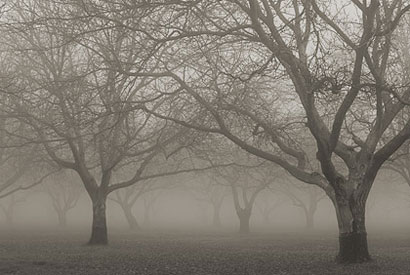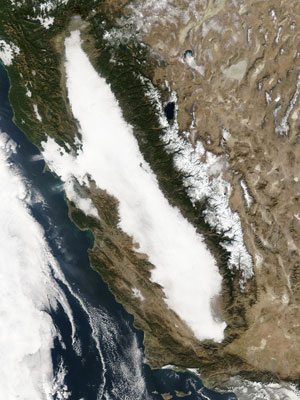Central Valley sees big drop in wintertime fog needed by fruit and nut crops
California’s winter tule fog – hated by drivers, but needed by fruit and nut trees – has declined dramatically over the past three decades, raising a red flag for the state’s multibillion dollar agricultural industry, according to researchers at UC Berkeley.

Crops such as almonds, pistachios, cherries, apricots and peaches go through a necessary winter dormant period brought on and maintained by colder temperatures. Tule fog, a thick ground fog that descends upon the state’s Central Valley between late fall and early spring, helps contribute to this winter chill.
“The trees need this dormant time to rest so that they can later develop buds, flowers and fruit during the growing season,” said biometeorologist and study lead author Dennis Baldocchi, whose father grew almonds and walnuts in Antioch and Oakley. “An insufficient rest period impairs the ability of farmers to achieve high quality fruit yields.”
The study was published May 15 in the journal Geophysical Research Letters, a publication of the American Geophysical Union. The findings have implications for the entire country since many of these California crops account for 95 percent of U.S. production, the authors noted.
The researchers paired NASA and National Oceanic and Atmospheric Administration satellite records with data from a network of University of California weather stations, covering 32 consecutive winters. There was a great deal of variability from year to year, but on average, the researchers found a 46 percent drop in the number of fog days between the first of November and the end of February.

“The year-to-year variability we saw was likely influenced by whether the season was relatively wet or dry,” said Baldocchi, professor of Environmental Science, Policy and Management. “Generally, when conditions are too dry or too wet, we get less fog. If we’re in a drought, there isn’t enough moisture to condense in the air. During wet years, we need the rain to stop so that the fog can form.”
Other studies have marked the decline in the Central Valley of winter chill – the number of hours between 0 and 7 degrees Celsius. The number of hours of winter chill has dropped by several hundred since the 1950s, the study authors noted.
But ambient air temperature alone may not adequately reflect the heat experienced by the crops, said Baldocchi. Direct sunlight can heat the buds so that they are warmer than the surrounding air temperature. As a result, fog is important in shielding the buds from the sun and helping them accumulate winter chill.
Climate forecasts suggest that the accumulation of winter chill will continue to decrease in the Central Valley. Baldocchi said that fruit developers are already trying to develop cultivars that can tolerate less winter chill.
“Farmers may also need to consider adjusting the location of orchards to follow the fog, so to speak,” said Baldocchi. “Some regions along the foothills of the Sierra are candidates, for instance. That type of change is a slow and difficult process, so we need to start thinking about this now.”
The study was co-authored by Eric Waller, a UC Berkeley Ph.D. student in the Department of Environmental Science, Policy and Management.
The California Energy Commission supported this research.
RELATED INFORMATION
Winter fog is decreasing in the fruit growing region of the Central Valley of California (abstract of study inGeophysical Research Letters)
